| |
This article was
originally published in The Business Economist vol. 36 no.1
|
|
| |
The main responsibility
for delivering improvements in quality of the UK river and coastal
waters have fallen on the water companies since privatisation. The
UK Environment Agency identifies sources of pollution from the water
industry and requires capital investment, approved by the economic
regulator Ofwat at a five yearly price review, to deliver improvements.
Most of the visible and obvious sources of pollution directly caused
by the Water industry have been removed over the past 15 years.
More difficult decisions in the future have to be made on water
quality improvements that will consider the cost and benefits of
a proposed requirement. This is particularly true under the EU driven
Water Framework Directive (WFD), which requires all water courses
to maintain 'good ecological status', which not only requires a
view on sustainability but includes derogations where the costs
of a solution can be shown to significantly outweigh the benefits.
Whilst this is a study that has applied specifically to the UK water
industry, the 'polluter pays' and 'precautionary' principles that
environmental regulators and campaigners promote also affect other
sectors. Therefore being able to understand how these principles
are turned into economic values is likely to be of increasing significance
as the concepts of sustainability and Corporate Social Responsibility
achieve universal importance.
Background and theory
In order to accept a calculation of the costs and benefits from
choosing a particular level of pollution, we have to accept that
a socially optimal level of pollution can be established. As Coase
(1960) established, this requires the existence of property rights;
the right to use a resource. Pollution can be seen as using the
resource of a clean environment with its' cost being the impact
this has on habitats, the diversity of species etc. The government
(usually through the appointment of a regulator with a remit) has
the role to ensure that the equilibrium of socially optimal pollution
is reached, whether property rights sit with the polluter or with
those who suffer from the pollution. This requires clarity of who
has the property rights before the regulator can do this.
When there is no optimal level of pollution because cause and effect
of pollution with property rights cannot be established, or where
the existing level of pollution is clearly far in excess of where
an optimal level could be (due to absence of information, market
failure or transactional costs in excess of any potential solution),
then standards are likely to be the best way of achieving the desired
environmental impact. For instance in the UK water environment,
several European Directives have been the main source driving environmental
improvements in the recent past; the banning of sewage sludge disposal
at sea and the Bathing Waters Directives being examples.
However there is a risk with standards that due to information shortfalls
the regulator sets a standard at a level that encourages the amount
of pollution to be higher than it otherwise would be. An example
of this would be where changing technology would in any case have
resulted in reduced pollution as a side-benefit from normal market
forces.
The key advantage of using standards is that the focus on achieving
a specific level of pollution is outcome rather than input focused.
In measuring the costs and benefits of achieving an optimum level
of pollution, for instance through the use of environmental taxation,
the focus is more on inputs and expectations of what will happen
as a result rather than enforcing a level of standards to be met.
The Water Framework Directive concentrates on the management of
habitats on a catchment basis rather than setting standards that
apply across the board. This is further down the route of outcome
management, but still arguably requires an assessment of what outcome
is at the optimal level of pollution. The alternative to setting
an optimal level of pollution would be to insist on relative standards
through a requirement to show no environmental deterioration or
through targets (a 10% reduction in measured pollution over the
next 3 years, for instance).
Similar objectives at a national level have been set through CO2
emission targets and the Climate Change Levy mixture of taxation,
efficiency incentives to large energy users and subsidies to renewable
energy producers. However this is to meet a global pollution objective.
The application of this type of policy framework is more complicated
for the more localised water environment.
In applying a 'polluter pays' principle, valuation of benefits is
used to answer the question of 'how much' is a reasonable amount
to pay. This takes for granted that there is some optimal level
of pollution and that property rights to pollute exist at this level.
An alternative to this would be to apply a 'precautionary' principle,
whereby pollution should be avoided through emission limits based
on visible or likely harm, rather than allowing a level of pollution
that matches up costs and benefits.
WTP and WTA compensation
Traditionally there are two main ways that a monetary valuation
is placed on an optimal level of pollution. Willingness to Pay (WTP)
establishes a welfare value equivalent to purchasing a good and
therefore requires a preference between a monetary value and a particular
level of pollution. This inherently accepts therefore a prioritisation
in favour of the highest welfare outcome for the least cost (whoever
that cost falls on, whether it be taxpayer or polluter profits).
The individual consumer favours a reduction in pollution until the
optimal level of pollution is reached.
The alternative to this concept is the Willingness to Accept Compensation
(WTA) from the polluter. In theory this should have the same value
as the WTP which most studies have measured. Those studies that
have compared both have largely found a higher WTA than a WTP, probably
due to WTA implying property rights with the sufferer of pollution
rather than the polluter.
|
|
|
Diagram 1
|
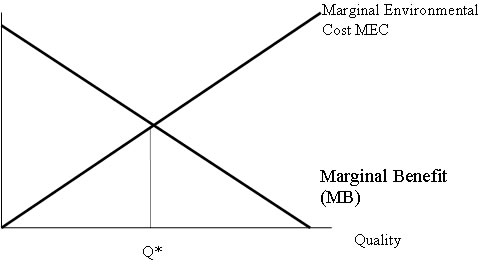 |
|
Diagram 1 establishes
a situation where the optimal level of pollution is reached at point
Q*. Above Q* the cost of achieving that level of environmental quality
is above WTP or WTA for it. This is effectively a comparison between
the marginal cost and the marginal benefit from moving from one
level of pollution to another.
The way that WTP has been applied in practice can be seen in the
UK water industry. The Environment Agency identified potential water
improvements that could be improved through changing the activities
of a water company, for instance by providing for a higher level
of treatment at a sewage works than previously required. Where there
is a statutory requirement to enact the improvement, no assessment
of the costs and benefits is carried out. For other optional schemes,
a Benefit Assessment Guidance process was developed by the EA. This
was largely based on an assessment of benefits that could be transferred
based on a review of previous WTP studies. The benefits of the improvements
were largely assessed on a national basis and then applied pro rata
to individual local schemes. This has the advantage of being a relatively
simple and easily applied approach to comparing the costs of benefits.
In effect it provides for a simple hurdle cost rate that varies
with the perceived benefit from the scheme and the population that
are seen to benefit from it. The benefits valued not only include
amenity from use or enjoyment of a water body but also non-use or
heritage values from the knowledge that the sustained environmental
quality will be available in the future. However this approach to
WTP also has particular disadvantages:
- Use and non-use values could not be adequately split from the
WTP studies.
- The studies themselves produced wide ranges of WTP estimates for
a similar quality improvement
- Population circles and average population density numbers were
used even for coastal and rural areas (in other words a coastal
scheme would include benefits for people who apparently lived out
at sea!)
- No mechanism for reflecting 'polluter pays' and the impact of
diffuse pollution existed. In effect the benefit transfer process
reflected a 'consumer pays' principle given that the studies asked
water consumers what they were willing to pay through an increase
in bills.
- Disbenefits from the proposed improvement (eg from increased power
consumption) were not directly considered.
Some of the difficulties with WTP studies can be seen from a brief
review of some of the research used in the EA BAG approach.
Georgiou et al (2000) derived positive willingness to pay from contingent
valuations from 'protecting the environment', 'for the sake of children/future
generations' and 'for wildlife'. However 54% of the local people
interviewed in the study of the River Tame used in the study had
never actually visited it. The survey itself was based around a
more general urban regeneration scheme for the area and therefore
the transferability of benefits to more general environmental issues
is questionable.
ERM (1997) established a willingness to pay from a study involving
three rivers, including the River Tavy in the South West. However
only 1/3rd of those surveyed had any WTP and only 50% of those who
did were definite about it. More interestingly, the study also suggested
that those surveyed did not recognise the environmental problem
described as impacting their own local river. This highlights the
risk that contingent valuation studies can overestimate a WTP when
compared to a real economic transaction. The study also found that
the WTP would be extremely low if a levy was simply attached to
water service bills. This suggests that the method of payment and
environmental improvement results in a significant difference in
WTP even for the same environmental improvement. In other words,
it matters who pays, and how.
EFTEC (2002) took a valuation approach based on a cost through water
charges compared to a 1% smaller risk in stomach upsets through
improving the quality of coastal bathing waters. The study also
included valuations through reducing sewage-related litter, although
the valuation appears to include other beach litter including dog
mess. The study also suggested that people were more concerned with
having accurate water quality notices rather than being willing
to fund reducing the risk of occasional failures in water quality.
This again emphasises that the basis of the study needs to be reflected
in how it is transferred in making cost benefit assessments of particular
schemes. Around 30% of the people surveyed in this study expressed
a zero willingness to pay. Around 50% of these expressed a negative
willingness to pay as they made statements such as "too much
has been spent already". Those who were seen as a making a
protest about the level of water charges were excluded from the
overall WTP the study identified, on the grounds that they must
gain some utility from the improvement claimed. We show later why
such an opinion from the survey is logical from an economic perspective
and therefore why excluding such individual opinions results in
a significant over-estimate of the WTP.
The assumption of economic rational behaviour towards utility gains
from environmental improvements is a key assumption in environmental
economics. This assumption requires consumers to value one unit
of utility gained at the same amount of one unit of utility lost
or forgone. However prospect theory and research into individual
approaches to risk contradicts this view. Kahneman & Tversky
(1979) set out that it is logical to be risk averse for gains whilst
being risk seeking for losses. This inconsistency between choices
is that people are willing to take a chance of avoiding a loss altogether
and accepting a risk of a much larger loss rather than take the
certainty of a relatively smaller loss. The sociology of this economic
decision is that people are in general more sensitive to negative
rather than positive stimuli. In a choice on environmental quality
between the large chance of a small environmental gain but with
a small chance of a large loss and no change in status, the preference
will be for no change in status. This suggests that marginal environmental
improvements that have a small chance of a negative counter effect
(either through odour from works, higher energy use or bills) should
have an inferior utility valuation to simpler schemes that manage
the environment to maintain the current level of environmental quality
(assuming that this is stable). This would support the emphasis
in the Water Framework Directive of maintaining good ecological
status rather than seeking specific environmental goals and social
utility gains as has often been used to justify water quality schemes
in the past.
Tversky & Kohler (1994) found "that probability judgements
are linked not to events but to the descriptions of the events…
the judged probability of an event depends on the explicitness of
its description". This highlights an important shortcoming
in contingent valuation studies in assessing consumers' attitude
to environmental risk. Tversky also found evidence for what is described
as 'ambiguity aversion'; people prefer known to unknown risks. If
an environmental problem as described is not one that reflects their
own experience this will affect the validity of the value that they
put on the environmental gain. As we have shown earlier, the WTP
studies frequently found a large non-use existence value based on
a description of environmental damage that did not reflect their
own environmental experience. The valuation they gave therefore
reflects the value to them of their own environment worsening to
that described rather than being a benefit that can be applied to
their own environment of a marginal change in environmental quality
from its current status. Choice experiments that provide people
with information may result in an exaggerated WTP. Choices can also
be logical even though they do not appear to be rational. It is
instinctive to human survival for known risks to be accepted more
than unknown ones. For instance, cars are more dangerous than plane
transport for the same journey. However, we use cars every day and
understand how they work so accept the day to day risk. Most people
travel by planes on an irregular basis and therefore fear the risk
more. This attitude to risk can also be applied to decisions on
environmental quality. Similar use of prospect theory to this was
suggested by Pearce (2002) in a report for the Environment Agency,
although the EA do not appear to have taken the logic into account
in their application of WTP studies.
A recent working paper (Langford et al, 1998) suggested that public
perceptions of health risks from polluted coastal bathing waters
varied using cultural theory, where consumers are categorised as
hierarchists, egalitarians, fatalists or individualists. Evidence
was found that hierarchists and egalitarians reduced their WTP established
through a contingent valuation study when told that the improvement
would be funded through higher water bills. Fatalists and individualists,
by their cultural nature, would not logically value a WTP that included
non-use values, although they did not reduce their WTP based on
water bills rather than taxation as to them these were considered
equally as bad methods.
|
|
Diagram 2
|
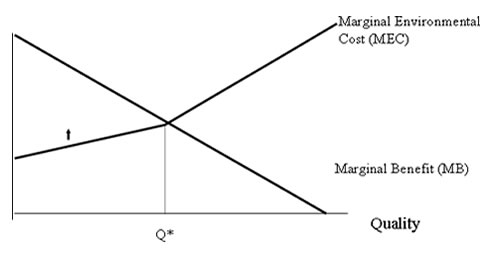 |
|
As we identified
before, the WTP of consumers will be affected by the standards that
are imposed in general even before an individual choice is made.
A no deterioration requirement, for instance, may result in a kink
in the WTP line for a particular level of environmental improvement
as shown in Diagram 2. This is because a level of stranded asset
investment would be required to maintain a particular level of pollution.
This result could not have been achieved through taxation as this
standard would be set because the optimal level of pollution is
unknown. If all costs were fixed for the current level of pollution
and the real optimal level of pollution was below the standard then
the result would be sub-optimal overall.
In the water environment we should also consider that some causes
of pollution are more measurable and controllable than others. For
instance, climate change that affects the flow of water in the river
will have an ecological impact separate from the affects of abstraction
and discharge into the river. Agricultural run off is also a significant
cause of water environment damage. Whilst current policy is focused
on the effect of water company activity where the regulation of
the industry means that sufficient data is kept so that the impact
can be assessed, there is not a similar requirement of agriculture
to control nutrient run off from fields. This means that there is
a certain level of pollution beyond which a policy that focused
solely on pollution from one sector would fail to produce meaningful
costs and benefits (as the WTP for solving pollution from that single
source may already be exceeded). This may still result in an optimal
level of pollution, but at a cost higher than would otherwise be
obtained if the taxation/subsidies could be used on the agricultural
pollution rather than the cost of meeting standards being imposed
on the water industry.
|
|
Diagram
3
|
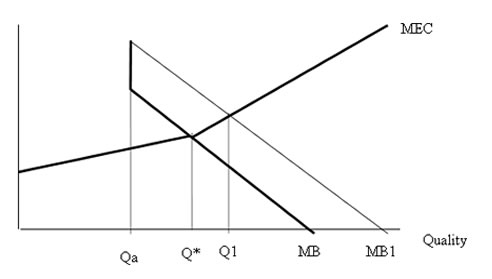 |
|
In Diagram 3 Qa
represents the environmental quality that would exist from agricultural
and diffuse pollution even with zero pollution from other sources.
MB1 represents the increased marginal benefit if agriculture could
be controlled through the same mechanism as other sources of pollution.
Q1 represents the real socially optimal level of pollution with
the triangle to the left of Q1 towards Q* being the extra cost imposed
on the other sources of pollution as a result.
As mentioned earlier, if Q1 is reached then there is still an optimal
level of pollution. However the measurement of the overall Willingness
to Pay may be affected by one source of pollution contributing more
to the Marginal Environmental Cost than would otherwise be the case.
Developing a risk based approach
To maintain a water body at a good ecological status requires a
balance between deciding on the quality of point sources of pollutant
discharge (such as from industry and sewage treatment works) and
managing the amount of diffuse pollution (such as from agriculture).
In general, tackling a point source of pollution will result in
both a discrete one-off cost and on-going step change in marginal
costs after that. Tackling diffuse pollution will in general involve
an increasing marginal cost for each element of improvement (for
instance by restricting the amount of fertilizers that farmers apply).
Therefore point sources of pollution by their nature face investment
in sunk costs if required to deliver an improvement, as shown in
Diagram 4. If there is uncertainty about the source, ecological
status or benefits from the improvement then it could be socially
better to tackle diffuse pollution first rather than forcing point
pollution sources to be improved. This suggests that a risk based
approach by applying ranges to both the costs and the benefits of
an improvement would produce better environmental decision making
than the existing Benefit Transfer and Cost Benefit ratio approach.
In applying this scenario any improvement between Q and Qa should
be achieved through tackling diffuse rather than point sources of
pollution. The disadvantages of this are that diffuse sources, by
their nature, are harder and more uncertain sources to tackle than
point sources. Another disadvantage is that this does not directly
reflect a 'polluter pays' principle, as the point source may be
contributing to the pollution problem but they are not paying their
share of the total WTP for improving the environmental quality.
|
|
Diagram 4
|
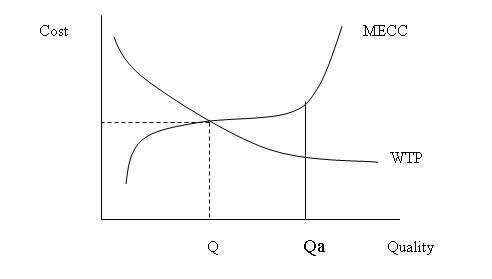 |
|
The solution should
be to apply confidence intervals around both the costs and the benefits
of an improvement, to reflect the degree to which both the step
change in point source costs and the diffuse pollution solution
are achievable and to reflect the range of benefits that the available
studies suggest are appropriate, including local surveys rather
than interpolating national total benefit valuations. The WTP benefit
can also be shown to vary with the level and significance of the
improvement compared to the existing local environment and the degree
to which the proposals represent the avoidance of a risk of deterioration
(when a higher Willingness to Accept Compensation valuation could
be used) rather than the potential benefits from a quality gain.
In Diagram 5, Q represents the current level of environmental quality
and WFD+5 represents the quality required under the Water Framework
Directive with a 5-year time horizon. However there is a risk with
WFD+5 that the cost will be significantly above the willingness
to pay, because the real cost and benefits could be between points
1 and 2 rather than the central estimate at point 0. To avoid imposing
excess costs on the point solution the Environment Agency should
seek to restrict diffuse pollution first to reduce this uncertainty.
There is a significant probability that this on its own could produce
the required environmental solution. A risk adjusted amount of money
could be 'taxed', eg through discharge licenses, from the point
source of pollution and used to provide compensation and fund the
reduction in diffuse pollution. If this proves not to be enough,
this money and complimentary amounts of compensation from diffuse
sources of pollution should be used to fund part of the step change
in cost imposed on the point source of pollution. To the extent
that these transfers from sources of pollution have other adverse
consequences, the WTP can be adjusted at a local level to reflect
this (eg the social consequences of a reduction in agriculture).
This results in simplified and locally applied pollution trading.
|
|
Diagram 5
|
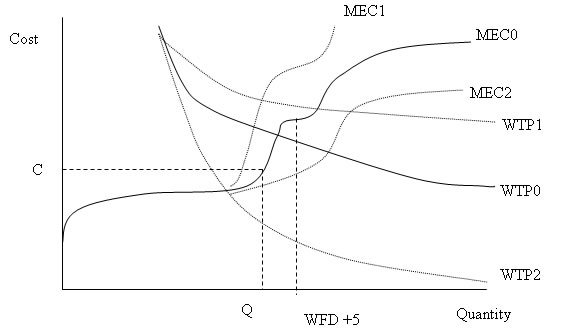 |
|
Conclusion
In conclusion, it would not appear to be appropriate to automatically
assume economic rational behaviour in justifying loading new environmental
costs on businesses using the 'polluter pays' principle. To meet
the concepts of sustainability and to reflect what is in reality
a 'consumer pays' principle requires the risks to the current environmental
status to be assessed and an approach that reflects future probability
and consequence into account. Environmental regulators and companies
should therefore refine their approach to sustainability to take
into account the social and cultural status of the ultimate consumers.
Future work proposals
Particular further areas of research that are apparent from this
paper are to examine how efficiency in terms of economies of scale
varies with specific local environmental regulation rather than
setting overall environmental outcomes that have to be achieved.
It would also be interesting to then compare the approaches for
environmental assessment to those used in establishing levels of
customer service and product quality. This may help to establish
alternative methods of evaluating environmental improvements than
using contingent valuation studies and other similar approaches.
Bibliography
Ackerman, F, 'Priceless Benefits, Costly Mistakes: What's Wrong
with Cost-benefit Analysis?' Post-autistic Economics Review, Issue
25,
2004.
Bann, C, Fisher, J, & Horton, B, Review of Non-use Values for
Water Quality and Water Resources and Values for Bathing Water Improvements,
Environment Agency, 2003.
Coase, R, 'The Problem of Social Cost', Journal of Law and Econmics,
3, 1960.
EFTEC, Valuation of Benefits to England and Wales of a Revised Bathing
Water Quality Directive and Other Beach Characteristics Using Choice
Experiment Methodology, DEFRA, 2002.
ERM, Economic Appraisal of the Environmental Costs and Benefits
of Potential Solutions to Alleviate Low Flows in Rivers, Environment
Agency, 1997.
Georgiou, S, et al, 'Contingent Ranking and Valuation of River Water
Quality Improvements', CSERG Working Paper, GEC, 18, 2000.
Kahneman, D, & Tversky, A, 'Prospect Theory: an Analysis of
Decision Under Risk', Econometrica, Vol 46, No2, 1979.
Langford, I, et al, 'A Cultural Theory Analysis of Public Perceptions
of Health Risks from Polluted Coastal Bathing Waters', CSERG Working
Paper, GEC, 20, 1998.
Pearce, D, The Role of 'Property Rights' in Determining Economic
Values for Environmental Costs and Benefits, Environment Agency
Bristol, 2002.
Pearce, D, & Turner, K, Economics of Natural Resources and the
Environment, Prentice Hall, 1990.
Tversky, A, & Kohler, W, 'Support Theory: a Non-extensional
Representation of Subjective Probability', Psychological Review,
Vol101, No4, 1994.
Willis, K G, Environmental Benefit Assessment, UKWIR EQ/01, 2004.
|
| |
| |
| |
|





